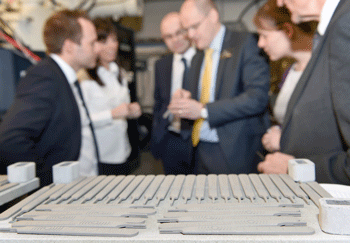UK MIM specialist CMG Technologies targets users of metal 3D printing technology
July 7, 2015
CMG Technologies, the UK’s leading Metal Injection Moulding (MIM) specialist, states that it has trademarked the term ‘CMG Technologies 3D Metal Moulding®’ as part of the company’s efforts to raise awareness of the scope of opportunities offered by MIM.
The company believes that whilst more and more manufacturers are becoming familiar with the capabilities of metal 3D printing/Additive Manufacturing, the process and benefits offered by Metal Injection Moulding are less well-known in the UK.
CMG’s Technical Sales and Marketing Director, Rachel Garrett, stated, “Although 3D printing has been around for more than 30 years, it is only in recent years that it has become widely recognised in the manufacturing industry. The term 3D printing has captured the attention of both industry and the general public and this, we believe, coupled with significant developments in technology which reduced both the size and costs of 3D printing machines, has played a vital role in the process gaining widespread understanding.”
CMG is hoping to replicate the success of this transition for Metal Injection Moulding. MIM is still a relatively new industry and a significant number of companies that need to procure complex metal components may not be aware of its existence, let alone the savings they could make in terms of cost, lead times and environmental impact.
The phrase ‘3D metal moulding’ paints an immediate picture of what it is that CMG Technologies actually does, explained Garrett. “Whilst the term Metal Injection Moulding describes the process well, it is not always exactly clear what the outcome is – 3D parts moulded from metal. To those involved in this industry like we are, this sounds obvious, but to people unfamiliar with MIM hopefully this term makes it easier to understand what we do.”
CMG believes that whilst 3D metal printing technologies are developing at an extraordinary rate, there are currently still limitations as to their capabilities. The technology is still predominantly used for prototype production as the technology is not yet fast enough to cope with mass production. 3D metal printing can also only be used to produce components from a relatively small selection of materials.
“Rather than being seen as a competitor to 3D metal printing, MIM can actually provide the stepping stone needed between prototype and volume production. Once the initial tooling is complete we are able to deliver huge volumes of parts in a far wider variety of materials than is currently possible with 3D printing,” Garrett stated.
Metal Injection Moulding is perfect for producing parts with complex geometries and even the smallest of parts can be perfectly replicated time and time again. As an example, CMG stated that it has the capability to manufacture a component with major dimensions of just 1.85 mm x 1.60 mm x 0.835 mm with a 100 µm hole and a small groove on one of the faces – at significantly lower costs than using traditional manufacturing methods.
CMG stated that its MIM facility is most effective for small, complex components in annual volumes of 1000 or more, although if the part is particularly complex and expensive the process could still be cost effective for volumes of 500 or more. Globally, MIM technology providers can deliver extremely high volumes of a complex 3D part, with some components being produced at a rate of several million parts per month for sectors such as consumer electronics. Parts can be produced from a wide range of materials including titanium and precious metals, making the process particularly attractive for manufacturing parts used in the aerospace and medical devices sectors.
Metal Injection Moulding uses powdered metals, as in many metal Additive Manufacturing processes, but these are combined with a binding agent into a feedstock. At CMG the binder is removed after injection moulding by a heating process, followed by sintering.
Useful links
To submit news and articles for publication on Metal Additive Manufacturing email us at info@metal – am.com
Go to the Metal-AM homepage | View all news | Subscr ibe to our free e- newsletter

















